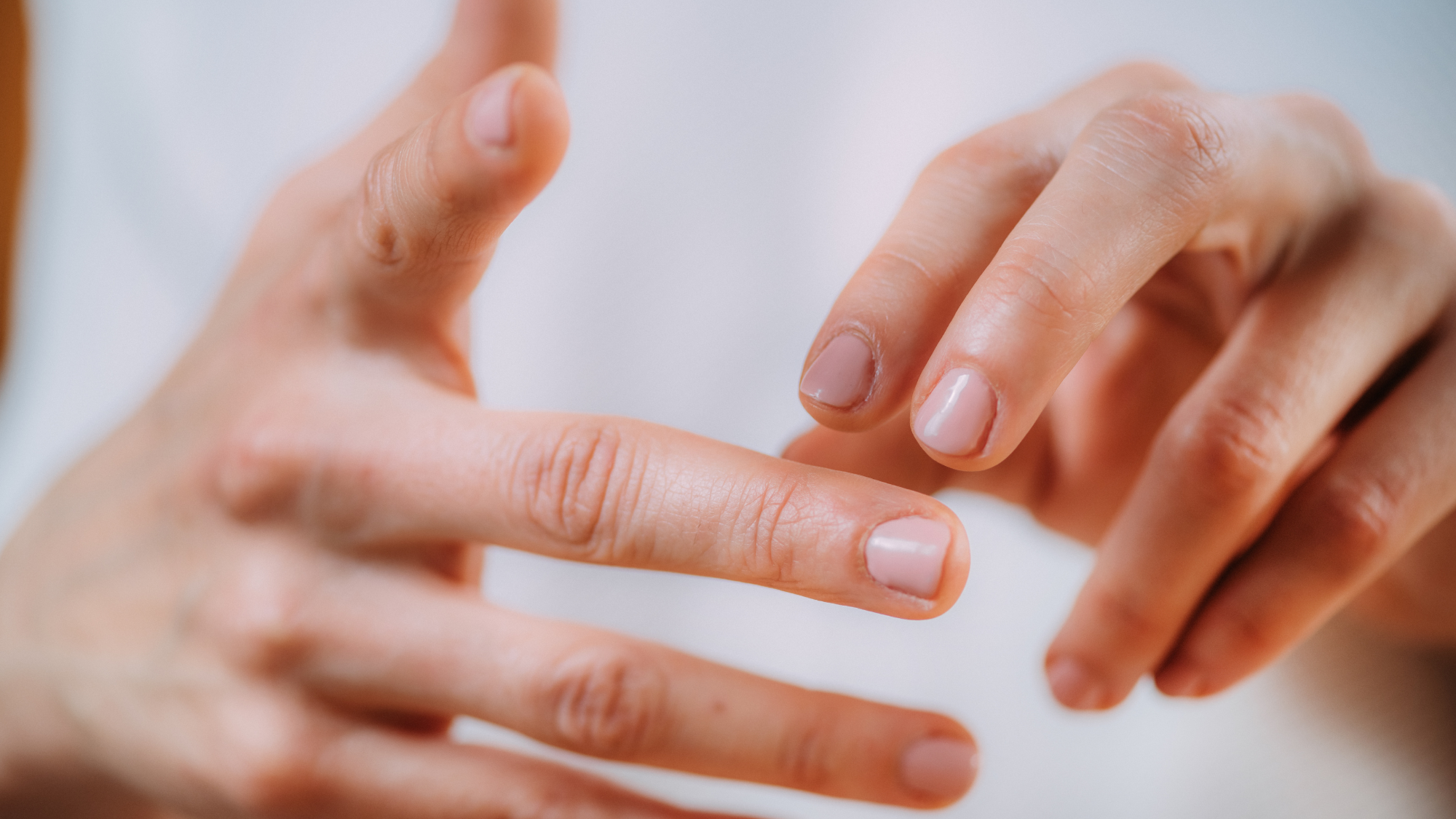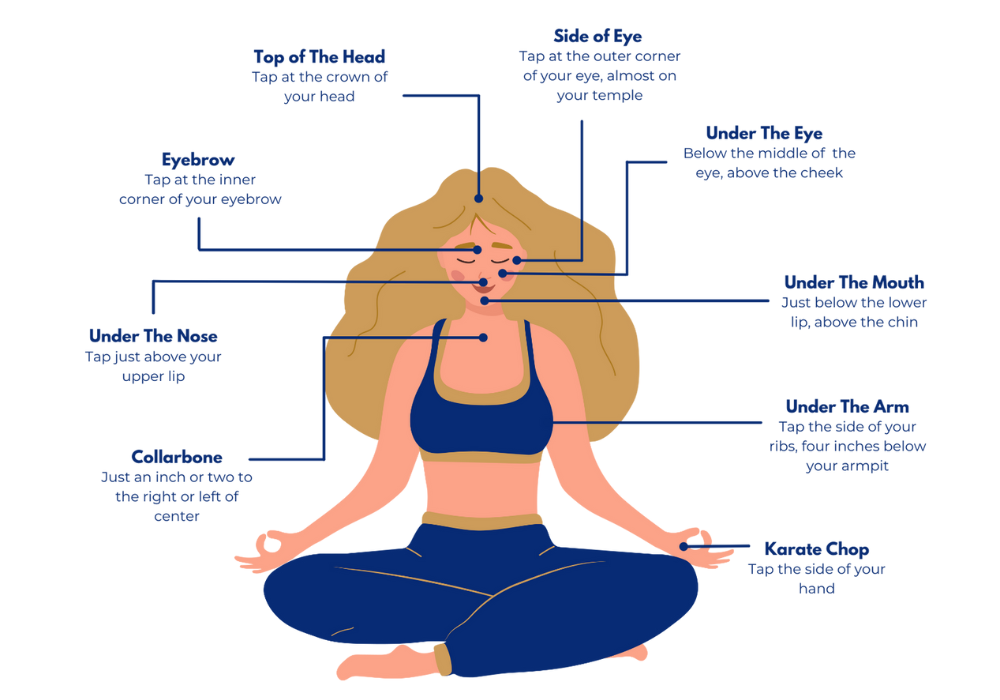Ever heard of tapping? Why experts reckon you should give it a go, if you're in need of stress relief
Introducing acupuncture without the needles...


Introducing acupuncture without the needles...
Ever heard of EFT tapping? In short, it's a wellness method that utilises your fingertips and the power of - yep, you guessed it, tapping - to reduce stress in five simple steps.
Otherwise known as Emotional Freedom Technique, experts in the field maintain that the power of EFT tapping is right at your fingertips - quite literally, as the practice encourages you to tap your fingers at certain pulse points on your body to ease tension.
A UK-wide 2018 study conducted by the Mental Health Foundation found that 74% of adults felt stressed to the point of overwhelm. Two years later, the World Health Organisation reported that the pandemic trigged a 25% increase in anxiety and depression worldwide.
Stress is one of the many emotions you may experience every day, but when it becomes chronic stress - aka, the kind that impacts your day-to-day life - it's important to try and reduce it. After all, MIND charity reports that it's been linked to health issues such as weight loss, hair loss, insomnia, fatigue and more.
EFT tapping has a growing body of research behind it and might just be the coping method you didn't know you needed. Keep scrolling for your need-to-knows, as renowned tapping expert Brad Yates answers all of your questions. Don't miss our guides to meditation, breathwork training and cold water therapy, while you're here.
EFT tapping: your guide
Wondering what EFT tapping even is? Let's start with the basics. Emotional freedom technique requires you to tap (or hold) the traditional acupuncture points on your body.
Celebrity news, beauty, fashion advice, and fascinating features, delivered straight to your inbox!
You've most likely heard or even tried acupuncture, and EFT tapping uses the same meridian points. According to Yates, it takes just five simple steps to achieve, meaning you only need ten minutes or so to tick this self-care idea off your to-do list.
Brad explains: "Tapping is the process of using your fingertips to stimulate key points around the face and body that have been used in acupuncture for thousands of years."
Alongside tapping on these points, there is a spoken component. This encourages you to identify your feelings and accept yourself for them.
EFT tapping benefits
So, wondering how tapping can improve your health? Good question. "Its primary benefit is reducing stress," shares the expert.
Not only that, but he goes on to add that the simple, try-at-home - not to mention, free - technique can improve:
- Encourage awareness
- Ease tension
- Provide light relief
- Regulate the nervous system through the vagus nerve
- Improve low mood
"A phrase we use in EFT? Tap on everything," he shares. Why? "Because most - if not all - of the issues that bother you, either physically and emotionally, are either caused by or worsened by stress."
People can use EFT tapping for a whole host of emotions - pain, sadness, or anger. Yates explains that, whatever your ailment, stress is often the underlying cause. He describes it as a "complementary therapy", and goes on to add that it can work well with cognitive behavioral therapy (CBT). (There are actually elements of CBT in tapping which give it its semantic component).
While tapping can't promise to solve all of your problems instantly, it does offer a simple method for stress relief. Every body is different, and different holistic therapies will work for different people. It's important to point out that tapping is just that - an alternative therapy that is not, at current, backed by the NHS. It's still being researched - but, that said, there are, at current, over a hundred small-scale studies on the benefits. One study even found a link between tapping and reducing PTSD symptoms in war veterans.
So, how does it work?
First time you've heard of tapping? Then here's a bit of history for you.
"Acupuncture - and utilising the meridian system - have been around for thousands of decades," explains Yates. "That said, tapping is a relatively new process and was discovered in the late 90s."
Yates explains that it works by tapping (literally) into the polyvagal system and the vagus nerve, which run up and down your spine and is connected to your organs and emotions.
Yates goes on: "It can regulate the amygdala in the brain - aka the part which sends out messages, looks for threats and puts you into flight, fright or freeze mode. Tapping somehow down-regulates that response through the sympathetic nervous system."
There are also studies which show a reduction of cortisol, the stress hormone, he continues.
Not so keen to take your health into your own hands? Tapping may not be for you. "It's important to understand that your wellbeing is your responsibility," emphasises the expert. Tapping enables you to use somatic techniques alongside meridian points to calm overwhelm.
EFT Tapping: your step-by-step guide
1. Identify the issue
Start with identifying how you are feeling. Stressed? Anxious? Humans experience so many emotions every day that taking a minute to recognise how you are feeling can be beneficial in itself. You likely experience a whole range of emotions and feelings at any one point, but tapping with one of these things at the centre of your focus is the best place to start, shares the pro.
From this starting point, Yates shares that lots of different things may come up in the process - for example, he's worked with individuals who have remembered old memories or childhood trauma while tapping.
Try this: sit in a comfortable position, breathe deeply, and focus on your stressor. Then, while tapping (more on exactly how to do that at point four), allow your emotions to come through, and continue to tap on them as the emotion is released.
2. Assess your feelings
Next, rate how much the issue is bothering you on a scale of zero to ten. Zero means it's not bothering you at all, whereas ten means it's an issue that is really stressing you out or could not be any worse.
Yates also suggests using this moment to assess how it feels in your body. Tension in the shoulders? A clenched jaw? How can you feel this issue is physically bothering you?
3. Chose your phrase
This is the stage where you focus on your words, rather than the physical tapping aspect.
Think of a phrase that acknowledges your issue and but accepts that it is not a defining part of you - words of affirmation or self-love, if you like.
Using stress as an example, you might say (out loud or in your head): "Even though I feel stressed, I love and accept myself."
4. Tap on EFT Tapping points
Once you have identified the issue and created a phrase to tap on, it's time to tap through your EFT points.
Starting with the side of your hand, use your fingertips to tap on the side of your hand while saying the phrase above, out loud or internally, explains Yates.
Then tap through each point several times while repeating the phrase. "This is to release your energy block," shares the pro.
EFT Tapping points:
- Side of hand
- Side of the eye
- Eyebrow
- Under the eye
- Under the nose
- Chin
- Top of the collarbone
- Under the arm
- Top of the head.
5. Check in with yourself
Once you have tapped and repeated the sequence a few times, check in with yourself on a scale of one to ten again. How are you feeling?
In theory, your issue should feel less heavy. It's an achievement even if it has only gone down by only one. "Use this moment to recognise the change, and what this feels like," shares Yates.

Once you've got the hang of it, feel free to make it your own, shares the expert. Yates emphasises that the process is intuitive - do what feels best for you, whether that's saying the phrase out loud, holding the points instead of tapping, or tapping on both sides rather than one.
Ready to give it a try? Yates is dedicated to making tapping more accessible to everyone and has thousands of tapping videos on his YouTube channel (see below).
"I tried EFT Tapping to alleviate stress and anxiety - but did it work?"
I’m Dionne, 24, and I’m a trainee writer at Marie Claire UK. I was curious about EFT tapping and so gave it a go myself. Here’s how I got on.
"I was first made aware of EFT tapping by Shlomit Sofia Tipping, who took me through a step-by-step guide to help with stress. She told me that you don't need to believe in tapping for it to work - she believes that the benefits prove themselves. When I tried it, I felt more relaxed immediately and couldn't stop yawning - yes, I was that relaxed."
"At first, as Yates told me is often the case, I found it awkward to say my chosen phrase out loud while tapping. But when I tried his videos in the comfort of my own home and did the process without saying the phrase out loud, I was surprised with how much more comfortable I was and that I still experienced the benefits."
"I love the idea of having this tool at my fingertips for when stressful moments arise. However, I am pretty bad at sticking to a morning routine (or any kind of routine) so haven't tried it for more than seven days or so."
"When I spoke to Yates about this, he told me that it's okay to do it less frequently, say your phrase quietly in your head, or even hold onto the points instead of tapping them. Knowing this, I found myself holding the points in potentially stressful situations, like when I'm on a packed tube and worrying about being late. Holding onto the side of my hand or tapping on the side of my head makes me feel more at ease."
"It can be all-too-easy to tap away at a computer keyboard for hours on end, so I'm trying to remember to spend five minutes EFT tapping every day, as well. It's not a cure-all, and it won't be for everyone, but it has helped me. I would encourage everyone to give tapping a try - what have you got to lose?"

Dionne Brighton is the Social Media Editor at Marie Claire UK. After writing about everything from nail trends to celebrity style moments for Marie Claire UK, Glamour UK and Woman & Home, she now leads the brand’s social strategy. Her work transforming Marie Claire UK’s social platforms earned her a BSME Talent Award nomination.